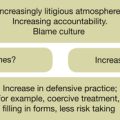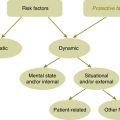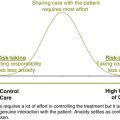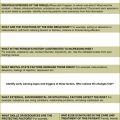Chapter 16 Psychodynamic principles and boundaries
However much he loves his patients he cannot avoid hating them, and the better he knows this, the less will hate and fear be the motives determining what he does to his patients.1
Taking a psychodynamic approach to the clinical presentation allows for an explanation of the mechanisms driving the risk behaviour. Risk behaviours (e.g. violence, suicidality, etc.) usually occur when an affect fails to be contained, regulated or linked to other mental mechanisms by thinking. Repetitive risk behaviours can be explored using the concept of repetition compulsion (see glossary). Past acts can be explored to discover their meaning for the patient and their continuing function in the here and now.
It is important to gain an understanding of the patient’s risk from the inside: understanding what the patient’s attitude to the behaviour is. Try to understand how the world is viewed through the patient’s eyes.2
• Does the patient express regret or remorse for the victim?
• Does the patient have capacity for empathy?
• Why has this particular person been chosen as the potential recipient of violence?
• Is there a theme to the patient’s self-harm or violence?
• Does the patient’s risk behaviour have an effect on particular staff? If so, what is the effect and why does it happen?
• Does the patient’s risk behaviour make sense in the light of the patient’s developmental history and life events?
Asking questions about fantasy will give further information which may help make sense of the risk behaviour, especially violence and sexual risks. For patients with chronic risk, a central theme of the treatment is an exploration of the emotions and cognitions driving the behaviour. For patients with ‘time-based and contingent suicidal intent’3 (see page 137), the proposed date of death is a communication whose meaning needs to be explored before it can be managed.
Psychodynamic approaches can also be used to explore individual and group responses to perceived risk. Fear, anxiety, anger, panic, denial and so forth can be considered at both an individual and a group level. Individually, a clinician may reflect on their own practice but can also use supervision and second opinions. In a team which is functioning healthily, group discussions will be facilitated by the team leader and will help reduce the likelihood of a collective abuse of emotional responses. Other group responses to perceived risk, such as rejection, scapegoating, malignant alienation,4 victimisation, prejudice, stigma and so forth, can also be explored with good facilitation by the team leader.5
Boundary issues
Some clinicians choose to suppress their emotional response, which reduces the risk of a breach of boundaries but also limits the opportunities to use the interpersonal relationship as a therapeutic tool. A common cause of difficulties leading to boundary violations is projective identification. In its simplest form, a patient projects an emotional state or belief onto their therapist unconsciously, because they are currently unable to incorporate it into their consciousness. For example, this may be an inability to express love. The therapist receives the projection of love and begins to behave (unconsciously acting out counter-transference) in a loving and caring way towards the patient beyond the usual levels of professional care. This process generally happens outside the awareness of both patient and therapist. As may be imagined, this can cause mayhem within treatment, but it can also be a cause of boundary violation. Counter-transference in its simplest form is the clinician’s emotional response, which stems from both the specific relationship with the patient and the character and disposition of the clinician. When counter-transference is a conscious response, it can shed light on the patient’s personality and ways of relating, but when unconscious it may give rise to well-rationalised but destructive acting out by the clinician.6
As described above, the counter-transferential responses of anxiety, fear, anger and love can all be used to assist in the assessment as well as the care of the patient, but if they are not conscious and managed by the clinician, they may be expressed within the therapeutic relationship inappropriately, will lead to poor outcomes and may well lead to a boundary violation. Crossing therapeutic boundaries is a problem which has been highlighted in the media, especially when there has been sexual contact with a patient. However, this is the most overt form of harm which is read about. The more subtle harms, often covert misuse of anger and reflexive responses to anxiety, are equally damaging and more pernicious. Equally destructive is the reflexive response, when faced with a difficult patient, of resorting to the moral high ground of rationality and the ‘scientific attitude’.7
Boundary violations do not suddenly happen. A common sequence involves a transition from last-name to first-name basis, then personal conversation intruding on the clinical work, then some body contact (e.g. pats on the shoulder progressing to hugs), then sessions over lunch and finally sexual intercourse.8
For more detailed explorations of this topic, suggested books are:
• Gabbard GO, Lester EP 2002 Boundaries and Boundary Violations in Psychoanalysis. American Psychiatric Publishing. Online. Available: http://appi.org/book.cfm?id=62098 (accessed 22 Nov 2009)
• Gutheil TG, Brodsky A 2008 Preventing Boundary Violations in Clinical Practice. The Guilford Press. Online. Available: http://www.guilford.com/cgi-bin/cartscript.cgi?page=pr/gutheil (accessed 22 Nov 2009)
Exercise 4 — boundary issues: John, Sarah and Lynley
1. John is 35 years old and presents with an impulse control disorder. He has a history of assaulting his girlfriends. You are also 35 years old, male, and your current girlfriend has had a troubled past in some of her relationships.
2. John is 35 years old and presents with an impulse control disorder. He has a history of assaulting his girlfriends. You are also 35 years old, female, and have been threatened by men in the past.
3. Sarah is 23 years old, self-harms, and presents in a slightly sexually provocative but also vulnerable and helpless way. You are:
4. Lynley is a 45-year-old woman with an anxiety disorder and dependent personality traits. You assess her as moderately depressed and feel that you can manage her within the home-based treatment team. Her family demand that she be admitted and say that if you refuse, they will complain to the ombudsman and go to the national newspapers.
Refer to Appendix 3 for a discussion of Exercise 4.
Questions to ask yourself when boundary issues are concerned:
• Are you maintaining your professional role? If in doubt, read your profession’s code of conduct guidelines or ask a colleague.
• Are you maintaining good professional boundaries when you see your patients? Are you seeing them within clinic hours or after hours? Have you started seeing your patients during your lunch hour or over a cup of coffee?
• When transporting a patient, especially one of the opposite sex, do you have a colleague with you in the car?
BOX 16.2 BOUNDARY ISSUES
• Have you considered issues of self-disclosure and physical contact in your practice?
1 Winnicott D.W. Hate in the counter-transference. International Journal of Psychoanalysis. 1949;30:69–74.
2 Grounds A. Risk assessment and management in clinical context. In: Crichton J., ed. Psychiatric Patient Violence — Risk and Response. London: Duckworth; 1995:43–59.
3 Gutheil T.G., Schetky D. A date with death: management of time-based and contingent suicidal intent. American Journal of Psychiatry. 1998;155:1502–1507.
4 Watts D., Morgan H.G. Malignant alienation. dangers for patients who are hard to like. British Journal of Psychiatry. 1994;164:11–15.
5 Murphy D. Risk assessment as collective clinical judgment. Criminal Behaviour and Mental Health. 2002;12:169–178.
6 Doctor R. Psychodynamic lessons in risk assessment and management. Advances in Psychiatric Treatment. 2004;10:267–276.
7 Hinshelwood R.D. The difficult patient. The role of ‘scientific psychiatry’ in understanding patients with chronic schizophrenia or severe personality disorder. British Journal of Psychiatry. 1999;174:187–190.
8 Gutheil T.G., Gabbard G.D. The concept of boundaries in clinical practice: theoretical and risk management. American Journal of Psychiatry. 1993;150:188–196.







